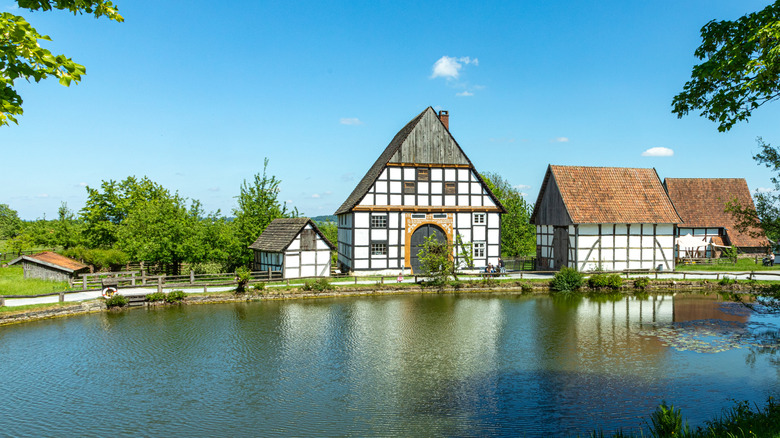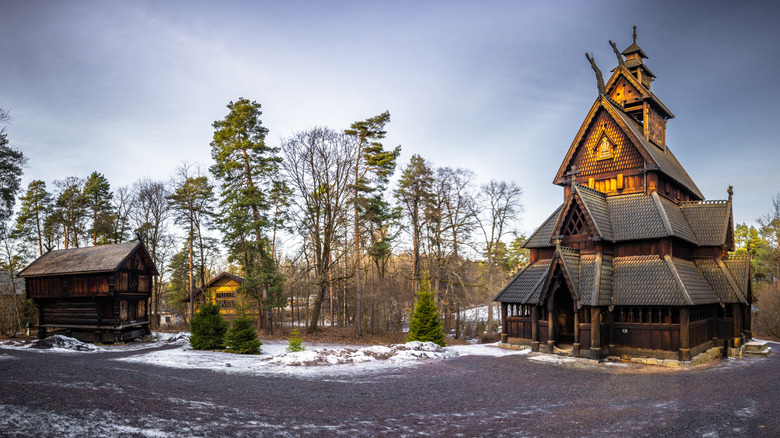Rick Steves Recommends This Fun Activity To Experience Europe's 'Old World' Culture
European cities can feel like outdoor museums at times. You can barely take more than a few steps in places like Athens and Rome without stumbling upon an ancient monument. But much of Europe now sits firmly in the 21st century, and it can be hard to grasp the rhythms of life in centuries past. Veteran Europe traveler Rick Steves has a solution in Europe's open-air folk museums. As he writes on his site: "These museums can be simultaneously fun and enlightening — a magic carpet ride through a culture's past."
So what exactly is an open-air folk museum? It's a curated village, where historic buildings are gathered together, and traditional crafts and customs are showcased in a natural outdoor setting. These museums tend to be set up like real towns or rural communities, with relocated or reconstructed homes, farms, businesses, and even entire churches, transported from various regions of the country.
Many museums feature interpreters in traditional dress demonstrating crafts, like weaving and blacksmithing. Steves admits that "it's culture on a lazy Susan, with an often cleaned-up version of an area's preindustrial lifestyle." But there's no doubt that it's an immersive way to experience how ordinary people lived, worked, and celebrated.
Open-air folk museums in the Nordic countries
Folk museums originated in Scandinavia, and Steves says on his blog, "that's still where you'll find the best ones." The first to open was Skansen in Sweden. This fantastic museum is on a sprawling site on one of Stockholm's islands and has over 190 buildings spanning the 14th century right up to the 1950s. During a varied visit, you can learn about local animals, get an insight into boat-building techniques, visit the spice shop, and even enjoy seasonal markets. Visitors have high praise for this museum, with many saying you can spend the whole day there and it offers something for all ages.
In Oslo, Norway, the Norsk Folkemuseum is home to a building even older than those in Stockholm. The wooden Stave Church dates to 1200 and has intricate carvings of humans, animals (including dragons!), and even runes. The museum contains countryside and town sections, allowing visitors to experience the rural and urban life of Norway's past.
If you'd like to focus on Europe's urban past, head to Den Gamle By in Aarhus, Denmark. First, you step back to visit 2014 street, where DVDs and a tanning salon showcase Denmark's most recent history. Then, you can go further into the past with three more time periods to explore: the mid-1900s, the early 1900s, and 1600-1900. Each period contains shops, homes, gardens, and goods to buy, with the earliest time transporting you back to the Denmark of Hans Christian Andersen.
Folk museums in the rest of Europe
Folk museums are concentrated in northern Europe (though you'll find them scattered all over the continent if you look hard enough!) The open air museum in Arnhem is one of Rick Steves' top destinations when traveling to The Netherlands. There you can get an insight into how the Dutch started using windmills, play with 19th-century toys, and see how laundry was done in days gone by.
Another of Steves' picks is Beamish in Northeast England. Across the enormous site, you can visit an 1820s-era tavern, a 1900s sweet shop, a World War II-era farm, and a 1950s police house. Perhaps the most unique attraction is the 1900s colliery, where visitors get to put on a hard hat and go down a coal mine and experience what working life was like for hundreds of thousands of miners at the turn of the 20th century.
More fantastic museums can be found in Eastern Europe. Tallinn's Estonian Open Air Museum is a fascinating side trip during a visit to a must-visit city in the Baltic countries. You can see farms from all over Estonia, as well as a school, a chapel, and a firehouse. Join in one of the museum's events, like the Midsummer celebrations or the Christmas activities during the festive season. Further south, Romania is home to the Village Museum in Bucharest. You can discover traditional Romanian village scenes from evocatively named regions, including Wallachia and Transylvania. As Steves says of these museums: "In more and more places they provide your only chance for a close-up look at the "Old World." Here are Rick Steves' favorite artworks to see in Europe.


